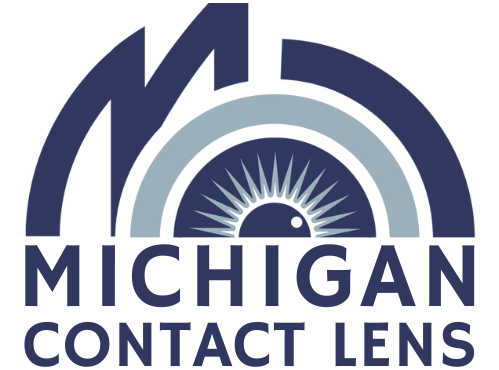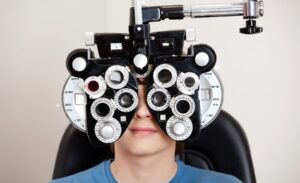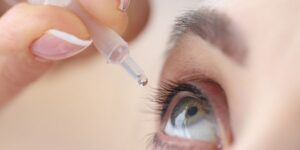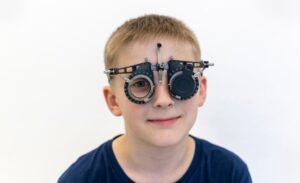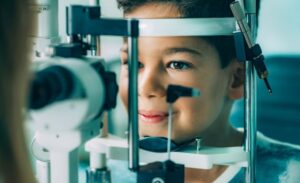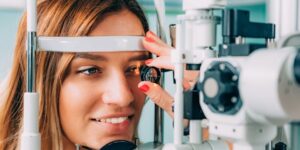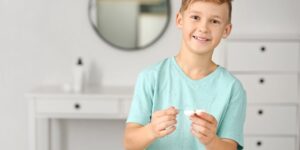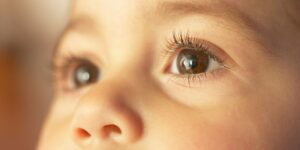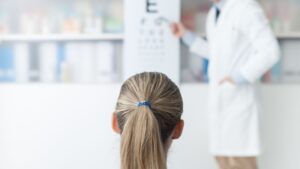Understanding Myopia Control
In order to comprehend the significance of myopia control, it is essential to have a clear understanding of what myopia is, the importance of controlling it, and the latest research in the field.
What is Myopia?
Myopia, commonly known as nearsightedness, is a refractive error that affects the ability to see distant objects clearly. Individuals with myopia typically have clear vision when looking at objects up close, but struggle with objects that are far away. This condition occurs when the eyeball lengthens, causing light to focus in front of the retina instead of directly on it. Myopia is becoming increasingly prevalent, especially among children and young adults.
Importance of Myopia Control
The importance of myopia control lies in the potential long-term effects of uncontrolled myopia. High levels of myopia are associated with an increased risk of eye conditions such as retinal detachment, cataracts, and glaucoma. Controlling myopia progression can help reduce the likelihood of developing these vision-threatening complications in the future.
Furthermore, myopia can have a significant impact on a child’s academic performance and overall quality of life. Children with uncorrected myopia may struggle to see clearly in the classroom, leading to difficulties in learning and participation. By implementing effective myopia control measures, parents and eye care professionals can work together to ensure that children’s vision is optimized for both academic success and overall well-being.
Latest Research in Myopia Control
Continuous advancements in myopia control research have led to the development of various interventions that aim to slow down the progression of myopia. Researchers are investigating different approaches, including pharmaceutical interventions, optical interventions, and behavioral interventions.
Pharmaceutical interventions involve the use of eye drops, such as atropine, to help control myopia progression. These drops work by dilating the pupil and inhibiting the eye’s ability to accommodate. While atropine has shown promising results, it is important to consult with an eye care professional to determine the most appropriate treatment plan for each individual.
Optical interventions include the use of specially designed contact lenses, such as multifocal contact lenses and orthokeratology lenses, to correct vision and slow down myopia progression. These lenses work by altering the way light focuses on the retina, reducing the strain on the eyes and potentially slowing down the elongation of the eyeball.
Behavioral interventions involve modifying certain lifestyle factors, such as increasing time spent outdoors and reducing screen time, to help control myopia progression. Studies have shown that spending more time outdoors and limiting the use of electronic devices may have a positive impact on reducing the risk of myopia development and progression.
Staying informed about the latest research in myopia control is crucial for parents and individuals concerned about myopia. By understanding the available interventions and their potential benefits, individuals can make informed decisions in consultation with their eye care professionals. For more information on myopia control methods, including contact lenses and other approaches, visit our articles on myopia control lenses and myopia control methods.
By actively engaging in myopia control strategies and keeping up with the latest research, individuals can take proactive steps towards managing and potentially slowing down the progression of myopia. Regular eye exams and discussions with eye care professionals are key to ensuring the best outcomes for individuals with myopia.
Factors Influencing Myopia Control
When it comes to myopia control, several factors come into play. Understanding these factors can help parents and eye care professionals make informed decisions about managing myopia in children. The key factors that influence myopia control are genetic factors, environmental factors, and screen time and outdoor activities.
Genetic Factors
Genetic factors play a significant role in the development of myopia. If one or both parents have myopia, there is an increased likelihood that their children will develop myopia as well. Research suggests that certain genes contribute to the development and progression of myopia. However, it’s important to note that genetics alone do not determine the outcome, and environmental factors also play a crucial role.
Environmental Factors
Environmental factors, such as lifestyle and visual habits, can influence the development and progression of myopia. Studies have shown that prolonged near work activities, such as reading or using electronic devices, can contribute to myopia progression. Additionally, inadequate outdoor exposure has been associated with a higher risk of myopia development. Encouraging children to spend time outdoors and engage in activities that promote distance vision can help reduce the risk of myopia progression.
Screen Time and Outdoor Activities
The increasing use of digital devices and prolonged screen time has raised concerns about its impact on myopia development. While there is no conclusive evidence linking screen time directly to myopia, excessive near work activities involving screens may contribute to myopia progression. It’s important for parents to encourage regular breaks and implement the 20-20-20 rule: for every 20 minutes of screen time, take a 20-second break and focus on something 20 feet away.
On the other hand, outdoor activities have been shown to have a protective effect against myopia. Spending time outdoors exposes the eyes to natural light, which is believed to play a role in regulating eye growth and reducing the risk of myopia. Encouraging children to engage in outdoor activities, such as sports or playtime, can be beneficial for their overall eye health.
Understanding the factors that influence myopia control is essential for parents and eye care professionals. By addressing genetic factors, modifying environmental habits, and balancing screen time with outdoor activities, it is possible to manage and potentially slow down the progression of myopia in children. Regular eye exams and discussions with eye care professionals can provide further guidance on myopia control methods. For more information on myopia control, please refer to our articles on myopia control contact lenses and myopia control lenses.
Latest Findings in Myopia Control Research
Continual advancements in myopia control research have paved the way for various interventions aimed at slowing down the progression of myopia. These interventions can be categorized into three main areas: pharmaceutical interventions, optical interventions, and behavioral interventions.
Pharmaceutical Interventions
Pharmaceutical interventions involve the use of medications or eye drops to manage myopia progression. One of the most promising pharmaceutical interventions is the use of low-dose atropine eye drops. Atropine, a medication commonly used to dilate pupils, has shown efficacy in slowing down myopia progression in children. Recent studies have demonstrated that low-concentration atropine eye drops, such as 0.01% or 0.05%, can effectively control the progression of myopia while minimizing side effects.
Optical Interventions
Optical interventions aim to modify the way light focuses on the retina, thereby reducing the strain on the eyes and slowing down myopia progression. One popular option is the use of multifocal contact lenses. These lenses have different zones that correct both distance vision and near vision. By providing clear vision at various distances, multifocal contact lenses can help reduce the eye’s need to accommodate and potentially slow down myopia progression.
Orthokeratology, commonly known as Ortho-K, is another optical intervention gaining attention. It involves using specially designed gas-permeable contact lenses to reshape the cornea overnight. This temporary reshaping of the cornea allows for clear vision during the day without the need for glasses or contact lenses. Studies have shown that Ortho-K can effectively slow down myopia progression in children.
Behavioral Interventions
Behavioral interventions focus on modifying habits and lifestyle factors that may contribute to myopia progression. These interventions typically target environmental factors, such as increased outdoor activities and reduced screen time. Research suggests that spending more time outdoors, especially during early childhood, may have a protective effect against the development and progression of myopia. Likewise, limiting screen time and maintaining a proper viewing distance when using electronic devices can help reduce eye strain and potentially slow down myopia progression.
By exploring the latest findings in myopia control research, individuals can make informed decisions about the most suitable interventions for themselves or their children. It’s important to consult with an eye care professional to discuss the available options and determine the best approach based on individual needs and circumstances. Regular eye exams play a vital role in monitoring myopia progression and ensuring timely intervention. For more information on myopia control methods, visit our article on myopia control.
Promising Strategies for Myopia Control
When it comes to myopia control, several strategies have shown promise in managing the progression of myopia in children. These strategies aim to slow down the progression of myopia and reduce the risk of high myopia, which is associated with potential vision-threatening complications. In this section, we will explore three promising strategies for myopia control: atropine eye drops, multifocal contact lenses, and orthokeratology.
Atropine Eye Drops
Atropine eye drops have emerged as a popular option for myopia control. These drops contain a low concentration of atropine, a medication that temporarily dilates the pupil and relaxes the focusing mechanism of the eye. By doing so, atropine eye drops help to slow down the elongation of the eyeball, which is the main cause of myopia progression.
Recent research has shown that low-concentration atropine eye drops are effective in reducing myopia progression in children. The drops are typically prescribed for nightly use, and their long-term safety and efficacy have been well-documented. It’s important to note that atropine eye drops should only be used under the guidance and supervision of an eye care professional.
Multifocal Contact Lenses
Multifocal contact lenses are another promising option for myopia control. These lenses have different zones that provide clear vision at various distances. By simultaneously correcting both distance and near vision, multifocal contact lenses help to reduce the strain on the eyes and slow down the progression of myopia.
Studies have shown that wearing multifocal contact lenses can effectively slow down myopia progression in children. These lenses are available in both daily disposable and reusable options, offering flexibility and convenience. However, it’s important to note that the suitability of multifocal contact lenses for a child should be determined by an eye care professional after a comprehensive eye examination.
Orthokeratology
Orthokeratology, commonly known as Ortho-K or corneal reshaping, is a non-surgical approach to myopia control. It involves wearing special rigid gas permeable contact lenses overnight, which gently reshape the cornea and temporarily correct the refractive error. By wearing these lenses during sleep, individuals can enjoy clear vision throughout the day without the need for glasses or contact lenses.
Orthokeratology has been shown to effectively reduce myopia progression in children. However, it requires strict adherence to wearing and hygiene protocols, as improper lens care can lead to complications. Regular follow-up visits with an eye care professional are necessary to monitor the corneal health and ensure optimal results.
While atropine eye drops, multifocal contact lenses, and orthokeratology are promising strategies for myopia control, it’s important to understand that the effectiveness of these methods may vary for each individual. Consulting with an eye care professional is essential to determine the most suitable approach for your child’s specific needs.
By staying informed about the latest research and discussing the available options with your eye care professional, you can make informed decisions about the best strategies for myopia control. Regular eye exams, as well as open communication with your eye care professional, play a crucial role in managing your child’s myopia and promoting their long-term eye health.
Discussing Myopia Control with Your Eye Care Professional
When it comes to myopia control, it’s important to have open and informed discussions with your eye care professional. Your eye care professional has the expertise and knowledge to guide you through the various options available for myopia control and help you make the best decisions for your child’s vision. Here are some key points to consider when discussing myopia control with your eye care professional:
Importance of Regular Eye Exams
Regular eye exams play a crucial role in myopia control. They allow your eye care professional to monitor the progression of your child’s myopia and assess the effectiveness of any interventions that have been implemented. Through comprehensive eye exams, your eye care professional can identify any changes in your child’s visual health and make appropriate recommendations for myopia control. It is recommended to schedule regular eye exams at least once a year to ensure that your child’s eyes are healthy and their myopia is properly managed.
Informed Decision Making
When discussing myopia control with your eye care professional, it’s essential to be well-informed about the various interventions available. Familiarize yourself with different methods, such as myopia control contact lenses, myopia control lenses, and myopia control drops, as well as other myopia control methods that may be suitable for your child’s specific needs. Ask your eye care professional about the benefits, risks, and expected outcomes of each intervention. By having a thorough understanding of the options, you can make informed decisions about the most appropriate approach for managing your child’s myopia.
Addressing Concerns and Questions
During your discussion with your eye care professional, don’t hesitate to raise any concerns or questions you may have regarding myopia control. It’s natural to have uncertainties about the interventions, potential side effects, or long-term implications. Your eye care professional is there to address these concerns and provide you with the necessary information to make educated choices. They can provide insights into the latest research, share success stories, and guide you through any potential challenges. Remember, effective communication with your eye care professional is key to ensuring the best possible outcome for your child’s myopia control journey.
By engaging in open and informative conversations with your eye care professional, you can gain a better understanding of the available options and make decisions that align with your child’s visual health needs. Regular eye exams, informed decision making, and addressing concerns are vital components of a comprehensive approach to myopia control. Together with your eye care professional, you can work towards managing your child’s myopia and promoting their overall eye health.
